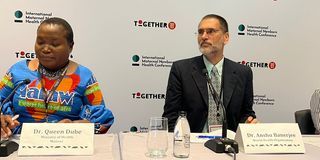Climate crisis worsening already high levels of maternal and newborn mortality: Experts

Dr Anshu Bernajee (right)- the Director for the Department of Maternal, Newborn, Child and Adolescent Health and Ageing at WHO and Dr Queen Dube from Ministry of Health Malawi during the Climate conference in Cape Town, South Africa.
Cape Town,
Scientists have disclosed that in developed countries nine out of ten pre-term babies survive while in developing countries the reverse is true.
This comes after the World Health Organisation (WHO) disclosed that the climate crisis is fueling respiratory diseases (including risk of asthma due to heat and air pollution), gastrointestinal disease, increased infant mortality due to extreme heat and the spread vector-borne diseases that are killing mothers and their babies at an alarming rate .
While presenting their findings at the international maternal newborn health conference currently ongoing in Cape Town, South Africa officials disclosed that there has also been increase in domestic violence cases across middle and low income household countries such as Kenya, stress due to domestic or intimate partner violence as well as deteriorated family functioning, family conflict and hostile parenting following extreme weather events.
The experts further highlighted that wasting, stunting and being underweight especially for rural children is due to excessive rainfall, extreme temperatures, and drought.
“Young children are particularly vulnerable to under-nutrition associated with climate-related events,” Elena Villalobos Prats from the department of climate change and health at WHO said.
“Reduction of the 4.5 percent of global carbon emissions due to healthcare including the over 70 percent of health footprint that is from supply chain procurement.”
While agreeing , the Partnership for Maternal Newborn and Child (PMNCH) who released data linking climate change to preterm births pointed out that the remarkable progress achieved for maternal and child survival in the past decades was not due to the health sector alone.
“Between 1990 and 2010, 50 percent of the global mortality reduction in children aged under five years was attributable to investments outside of the health sector and since the launch of the first Born Too Soon report, the importance of intersectoral action in health has been emphasized in the 2030 Agenda for Sustainable Development and the Global Strategy for Women’s, Children’s and Adolescents’ Health (2016-2030), both launched in 2015.”
The experts are of the view that extreme heat may trigger adverse birth outcomes including stillbirth, as it may cause a decrease in the ratio of body surface area to body mass, dehydration, preterm labor, and fetal distress and heart conditions.
“In turn, these physiological changes may decrease uterine oxygen and induce labor.
There is evidence that extreme temperatures, mostly extreme heat, increase the risk of stillbirth during the third trimester of pregnancy, this is especially the case amongst women in low socioeconomic groups.”
Speaking to the Nation in an interview on Monday, Ms Angela Nguku , the founder White Ribbon Alliance (WRA) said that those most affected by climate change are the least contributors to climate catastrophy.
“The climate crisis is worsening already unacceptably high levels of maternal and newborn mortality, climate change-related impacts are driving inequities in outcomes between and within countries.
The developing fetus, and newborns have specific biological vulnerabilities to the climate crisis, she said.
“ In particular the role of heat and air pollution on maternal and neonatal health is becoming increasingly established and includes higher rates of miscarriage, preterm birth and poorer neonatal outcomes.
Pregnant women are additionally vulnerable to heat-related illness and death. Newborns are especially heat-sensitive even compared to other children.,” Ms Nguku explained.
“ Extreme heat exposure during pregnancy is linked with increased rates of pre-term birth, low-birth weight and still-birth.”





